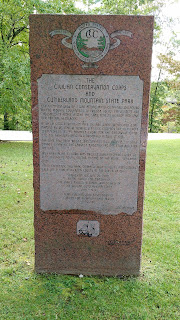I was debating on whether to tell you yesterday or today that Wednesday was the last entry in this series. Obviously, today won out. As I was typing through yesterday's post I guess I just wasn't ready to bring it to a close. Alas, today is that day.
So, whats's next? This seems a bit like the end of one of those movies where you get a quick update on what happened to the characters after the main story was over. Let's go with that.
Robert
Robert does have a few more entries in the journal. They take him up to Temple, Michigan for his next assignment. There is not much information though and I thought it would be good to end where he started, in Fort Sheridan.
In about a month from leaving Ft. Sheridan, Robert leaves the CCC program. I've got a recommendation letter dated 11/9/36 that mentions he is leaving for a job back home. I know that he spends some time driving a truck in the late 1930s, but am not sure if that is the job mentioned in the letter. Like many CCC boys, he goes in to the Army for World War II. Unlike his brothers, Robert would stay Stateside mainly in California where he would teach code to others in the military.
Robert left the military after the war as a partially disabled veteran. He had arthritis problems which he felt came from the years of sleeping outside and on the ground in the CCC. On his return to Cairo he did accounting work where he met his wife Margaret and would raise a family.
Robert passed away in 1984, one day before his 68th birthday. He had lived in Cairo the entire time. He was missed by many as he is today.
CCC
The CCC program started to dwindle down as the economy got better in the late 1930s. When young men could make more money at home than through the CCC program, they no longer signed up. While it had been shrinking for years, the formal end came in 1942 as the nation was focusing on the war effort.
Glacier National Park
Unlike the first two, the park is as busy as ever. The 1940 annual park visitor count was at 177,000. In 2007, it was at 2,083,000. You can go there now and take tours on the red buses, see Mt. Cannon, jump in Lake McDonald, and maybe even go in to Kalispell, but be careful. And stay away from the fires.
This Blog
I hope you enjoyed reading through this. My goal was to give you a very light summary of some of the subjects and spark some interest for further investigation. I know some of these lead me to much further reading.
I'll keep this blog up for future readers. I can't say that I'll be posting regularly to it, but I may add some supplemental posts as I come across CCC items. I'm hoping to go to the park next year and will probably post some then. There is a "Follow by Email" box on the blog page. Sign up here if you want to be notified when I make a post.
Me
Well, this has been an interesting venture. Career-wise this has been an extraordinarily busy time for me and getting a post out some days has been very tricky. Not having that daily 9:00 AM deadline will be nice, but I think it's good to have something in your life to make you accountable and push you to do the harder things. There are plenty of times people have things they want to do and put them off. After doing these posts I can tell you, there is always time if you make it, even if you can only do a little every day. I'm going to be looking for the next thing to fit in my extra little slivers of time. Any suggestions? Comment below.
Thanks for Reading!
 |
| Robert in World War II |
 |
| Robert and his wife Margaret |
 |
| Recommendation Letter |






























